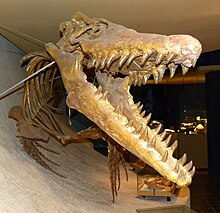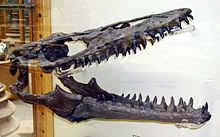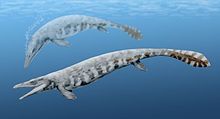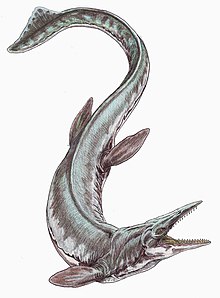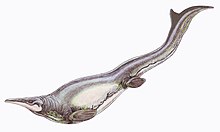Mosasaur
| Mosasaur | ||||||||||||
|---|---|---|---|---|---|---|---|---|---|---|---|---|

Hainosaurus in a living reconstruction . This tylosaurine from the Upper Cretaceous was up to 17 meters long. |
||||||||||||
| Temporal occurrence | ||||||||||||
| Upper Cretaceous ( Cenomanian to Maastrichtian ) | ||||||||||||
| 100.5 to 66 million years | ||||||||||||
| Locations | ||||||||||||
|
||||||||||||
| Systematics | ||||||||||||
|
||||||||||||
| Scientific name | ||||||||||||
| Mosasauridae | ||||||||||||
| Gervais , 1853 | ||||||||||||
The mosasaurs (Mosasauridae, "Maasechsen") were in the entire Upper Cretaceous a worldwide group of marine reptiles .
They are like the extant snakes , lizards and amphisbaenians to Schuppenkriechtieren (Squamata), reaching up to 18 meters in length. At the beginning of the 19th century, Georges Cuvier recognized, among other things, the fossil of Mosasaurus hoffmannii for the first time in the history of science that there is a possibility of extinction of living beings.
features
The extremities of the mosasaurs had developed into fins as an adaptation to the aquatic way of life, which, like some other fossil marine reptiles , showed the characteristics of the phenomenon of hyperphalangia (surplus finger joints). The long tail had a hypocercial fin at the end , i. H. the end of the spine curves down to support the lower, larger part of the caudal fin. The elongated skull was equipped with a very strong jaw. In the jaws of mosasaurs there were mainly pointed, mostly very similar teeth, but there were exceptions such as the genus Globidens with spherical breaking teeth. There was a joint in the middle lower jaw which facilitated the opening of the mouth. Mosasaurs had many vertebrae, the seven cervical vertebrae together with the mostly 22 dorsal vertebrae and the often more than 100 caudal vertebrae support the body of the mosasaur. The eyeball is protected by a ring of thin bone plates around it ( scleral ring ). Dark traces ( eumelanin ) in the fossilized soft tissue of mosasaur fossils show that they were dark in color and had a light underside.
Like the ichthyosaurs and plesiosaurs , the mosasaurs are said to have been able to keep their body temperature constant at a high level of 35 to 39 ° C ( endothermia ).
Way of life
nutrition
The teeth of the mosasaurs suggest that mosasaurs specifically fed on large nectons such as larger fish . Fossil finds, body structure and dimensions of mosasaurs suggest that seabirds (then about Hesperornis ) and low-flying pterosaurs were eaten, as well as various marine reptiles were probably hunted by mosasaurs (probably mainly juveniles), as well as ammonites . According to current knowledge, they did not pursue their prey in a hurry, but killed it in a quick surprise attack. Some mosasaurs used different strategies to get other food. The representatives of the genus Globidens broke off the mussels on mussel beds and ate them, similar to the placodontids that existed much earlier and at that time only survived in fossil form .
The mosasaurs could launch violent attacks with their sharp teeth, but the food could not be crushed with these teeth, so the prey had to be swallowed completely. The joint in the lower jaw allowed the jaw to be opened very wide and to absorb a lot of food. Palatine teeth did another.
Locomotion
The large extremities and body proportions of mosasaurs suggest that mosasaurs swam fairly agile. The main drive came from the powerful oar tail. An excavation in Jordan found a fossil of a prognathodon , which has a caudal fin with the longer part protruding downward rather than upward like most sharks do . Mosasaurs could have swum faster than previously thought with this caudal fin.
Reproduction
Since the discovery of mosasaur embryos within the bodies of adult animals and the discovery of a large, soft-shelled egg in marine deposits from the Upper Cretaceous of Antarctica, it has been considered likely that mosasaurs were ovoviviparous . In 1996, Gorden Bell described the fragmented remains of a plioplatecarpus found in South Dakota that recovered the bones of two embryos. 2001 was followed by the description of the Aigialosauriers Carsosaurus , in its rear part of the body four well-developed embryos were. The agialosaurs are considered to be the ancestors of the mosasaurs or their sister group . The location of the embryos indicated that, like whales and ichthyosaurs, they were born tail first. Mosasaur cubs were one to two meters long at birth. In the Niobrara Formation in Kansas , a collection of very young mosasaurs was found, the fossil remains of which were deposited in an area which in their time ( Campanium to Lower Coniacium ) was more than 300 km from the nearest coast of the Western Interior Seaway . So the animals were probably born in the open ocean.
Research history and fossil finds
Fossil evidence of mosasaurs is known in great intercontinental diversity. The first find was in a limestone building near Maastricht in 1770 . Troops during the French Revolution brought the find to Paris , where Georges Cuvier identified it as a lizard. A very rich and, with more than half a dozen genera, also diverse fauna of mosasaurs was discovered in the Ouled Abdoun Basin in Morocco . The finds date to the Maastrichtian .
Systematics
The closest relatives of Mosasaurier are small and not so much adapted to a marine life aigialosauridae , with whom they taxon Mosasauroidea form. The Mosasauroidea are probably very close to the recent monitor lizards and were a successful, but relatively short-lived side branch of the trunk line of the monitor lizards, which adapted to the marine way of life. A minority of scientists believe that mosasaurs are more closely related to snakes (serpentes) than to monitor lizards, and call the taxon that unites snakes and mosasaurs pythonomorpha .
Within the mosasaurs, a distinction is made between the more primitive Halisaurinae and the more advanced Natania. Within the subfamily Mosasaurinae there are strongly modified forms, z. B. developed a vomiting bite and how globidens became mollusc- eaters or specialized ichthyosaur -like fish-eaters such as Plotosaurus . The crocodile-like Goronyosaurus stands in isolation.
- Mosasauroidea
- Aigialosaurs (Aigialosauridae)
-
Mosasaur (Mosasauridae)
- Goronyosaurus
- Tethysaurinae
- Halisaurinae
- Natania
- Plesiotylosaurus , allocation controversial
- Prognathodon , allocation controversial
- Russelosaurina
-
Mosasaurinae
- Amphekepubis
- Eremiasaurus
- Moanasaurus
- Liodon
- Clidastes
- Globidensini
- Plotosaurini
etymology
The French-Belgian-Dutch river Maas is called “Mosa” in Latin. The first fossils were found near this river, hence the scientific name Mosasauridae, which means "Meuse lizard".
swell
literature
- Jasper James : The chalk. In: Nigel Marven , Jasper James: Monsters of the Deep. In the realm of primeval times. vgs, Cologne 2004, ISBN 3-8025-1573-0 , pp. 104–125 (translation of the English original edition from 2003).
- Oskar Kuhn : prehistoric reptiles. In: Bernhard Grzimek (ed.): Grzimeks animal life. Volume 6: reptiles. Unchanged reprint of the dtv edition from 1979/80. Bechtermünz, Augsburg 2000, ISBN 3-8289-1603-1 , pp. 38-72, here pp. 70 f
- Martin Sander : † Mosasauria, Maasechsen. In: Wilfried Westheide , Reinhard Rieger (Ed.): Special Zoology. Volume 2: Vertebrates or Skull Animals. Gustav Fischer u. a., Stuttgart a. a. 2004, ISBN 3-8274-0900-4 , p. 380.
Individual evidence
- ↑ a b Johan Lindgren, Hani F. Kaddumi, Michael J. Polcyn: Soft tissue preservation in a fossil marine lizard with a bilobed tail fin. In: Nature Communications. 4, Article number: 2423, September 2013, doi: 10.1038 / ncomms3423 .
- ↑ a b Nature, September 11, 2013 - MVI / NP: Marine dinosaurs with shark fin, mosasaurs were more agile than expected - thanks to shark-like tail fins in scinexx.de, date: September 11, 2013, accessed: September 11, 2013
- ↑ Johan Lindgren, Peter Sjövall, Ryan M. Carney, Per Uvdal, Johan A. Gren, Gareth Dyke , Bo Pagh Schultz, Matthew D. Shawkey, Kenneth R. Barnes, Michael J. Polcyn: Skin pigmentation Provides evidence of convergent melanism in extinct marine reptiles. In: Nature . Vol. 506, No. 7489, 2014, pp. 484-488, doi: 10.1038 / nature12899 .
- ↑ Aurélien Bernard, Christophe Lecuyer, Peggy Vincent, Romain Amiot, Nathalie Bardet, Éric Buffetaut , Gilles Cuny, François Fourel, François Martineau, Jean-Michel Mazin, Abel Prieur: Regulation of Body Temperature by Some Mesozoic Marine Reptiles. In: Science . Vol. 328, No. 5984, 2010, pp. 1379-1382, doi: 10.1126 / science.1187443 .
- ↑ T. Lynn Harrell, Alberto Pérez-Huerta, Celina A. Suarez. Endothermic mosasaurs? Possible thermoregulation of Late Cretaceous mosasaurs (Reptilia, Squamata) indicated by stable oxygen isotopes in fossil bioapatite in comparison with coeval marine fish and pelagic seabirds. Palaeontology, 2016; 59 (3): 351 doi: 10.1111 / pala.12240
- ↑ Lucas J. Legendre, David Rubilar-Rogers, Grace M. Musser, Sarah N. Davis, Rodrigo A. Otero, Alexander O. Vargas, Julia A. Clarke: A giant soft-shelled egg from the Late Cretaceous of Antarctica. Nature (2020), doi: 10.1038 / s41586-020-2377-7
- ↑ Richard Ellis: Sea Dragons. Predators of the Prehistoric Oceans. University Press of Kansas, Lawrence KS 2003, ISBN 0-7006-1269-6 , pp. 217-218
- ↑ Michael J. Everhart: Rapid evolution, diversification and distribution of mosasaurs (Reptilia; Squamata) prior to the KT Boundary. In: Tate 2005. 11th annual symposium in paleontology and geology. The Cretaceous-Tertiary boundary. Adaptive radiation after the bottleneck. Tate Geological Museum - Casper College, Casper WY 2005, pp. 16-27, online at oceansofkansas.com .
- ↑ Nathalie Bardet, Alexandra Houssaye, Peggy Vincent, Xabier Pereda Suberbiola, Mbarek Amaghzaz, Essaid Jourani and Saïd Meslouh: Mosasaurids (Squamata) from the Maastrichtian Phosphates of Morocco: Biodiversity, palaeobiogeography and palaeoecology based on tooth morphoguilds. In: Gondwana Research. Vol. 27, 2015, pp. 1068-1078, doi: 10.1016 / j.gr.2014.08.014 .
- ↑ Michael SY Lee: The phylogeny of varanoid lizards and the affinities of snakes. In: Philosophical Transactions of the Royal Society. Series B: Biological Sciences. Vol. 352, No. 1349, 1997, ISSN 0080-4622 , pp. 53-91, doi: 10.1098 / rstb.1997.0005 .
- ^ Cladogram at Oceans of Kansas
- ↑ Kladogram at Mikko's Phylogeny Archive
- ↑ László Makádi, Michael W. Caldwell, Attila Ősi: The First Freshwater Mosasauroid (Upper Cretaceous, Hungary) and a New Clade of Basal Mosasauroids. PLOS, December 19, 2012 doi: 10.1371 / journal.pone.0051781
- ↑ Takuya Konishi et al. A new halisaurine mosasaur (Squamata: Halisaurinae) from Japan: the first record in the western Pacific realm and the first documented insights into binocular vision in mosasaurs. Journal of Systematic Palaeontology, December 07, 2015; doi: 10.1080 / 14772019.2015.1113447
- ^ Johan Lindgren, Michael J. Everhart, Michael W. Caldwell: Three-Dimensionally Preserved Integument Reveals Hydrodynamic Adaptations in the Extinct Marine Lizard Ectenosaurus (Reptilia, Mosasauridae). In: PLoS ONE . Vol. 6, No. 11, 2011, e27343, doi: 10.1371 / journal.pone.0027343 .
